Upon arriving in San Francisco, what first struck me was the diversity. Diversity in ethnicity, languages, wealth, and interests. Everywhere you look there are words, and whether these words are understood or not they have a purpose. While there is a strong variety of languages throughout San Francisco, the linguistic landscapes in English, French, and Chinese throughout San Francisco will be focused on. Signs dispersed across this city are not simply physical structures, but have a plethora of purposes including communication, aesthetic, and marketing value.
First, English is the primary language of San Francisco understood by most of its population. For this reason, it is used in all public city signs (street/safety signs, city buildings, and vehicles signs). The consistent use of only English on these signs perpetuates the high status of the English language in San Francisco despite the fact that 45% of people in California speak a a foreign language (cis.org). The majority of businesses and restaurants utilize English in their signs and menus because it is easiest for communication. However English is also used because it is perceived as modern and trendy, especially when it is concise. For example, an ad reads “Free. Drive with Uber.” It is concise and portrays a modern and trendy image of a futuristic car. The use of English markets the idea that Uber is a modern experience, something that many people in San Francisco find attractive. However, English is not the only language that is used throughout this diverse city.
Despite San Francisco’s high French population, there are almost no French signs for communication value. However, there are many French signs on restaurant signs, menus, and sidewalk signs to attract customers to an authentic French feel. They are almost exclusively used for their marketing value. However, in Exhibit 1, English is used in window signs to really communicate to customers while French is utilized as a marketing tool. This restaurant makes sure to include commonly known French words in their signs like “brasserie” and “café” (Exhibit 2) so Americans will be drawn to this experience, increasing profits. Like the use of Chinese described by Leeman and Modan, French signs “focus solely on the aesthetic value of written language without engaging it as a vehicle of communication.” (Leeman and Modan, 357)
Lastly, the linguistic landscape of SF’s Chinatown attempts to market the Chinese culture to residents and tourists outside of the Chinese culture. However, unlike the French linguistic landscape, some of the Chinese truly provides communicational value to the city’s high asian population. The marketing value of Chinese is evident in the Chinatown arc that mimics asian architecture and displays Chinese characters (Exhibit 3). Few people actually read these characters, revealings its low communicational and high aesthetic value. Leeman and Modan explain it well: “Chineseness works as spectacle, on display largely for the benefit of outgroup individuals… Chinese writing has become less a means of communication… and more a symbolic design element.” (Leeman and Modan, 359) This adds to Chinatown’s economic value, clear that it attract picture taking tourists. Further into Chinatown, restaurant signs in red and gold display both the English and Chinese name of the business (Exhibit 4). Similar to French signs, the Chinese characters have marketing value while the English words beside them provide communicational value. However it is mostly small businesses that utilized this, not corporate businesses. Deeper into Chinatown, there are street signs in Chinese (Exhibit 5). There are less aesthetically pleasing Chinese establishments using more Chinese and minimal english. These are businesses that truly use Chinese to communicate. However, there is a gray area in which Chinese can be used for both marketing and communicational value.
In conclusion, at first glance San Francisco may seem as a melting pot of many languages. However, after examining its linguistic landscape, an overwhelming majority of official city signs are in English. The use of multilingual signs around the city are used to market businesses to increase consumer appeal. Instead of promoting other languages such as French and Chinese as a “vehicle for communication”, they are used for their marketing value. While businesses believe it increases their authenticity, it actually diminishes the language’s communicational value in San Francisco.
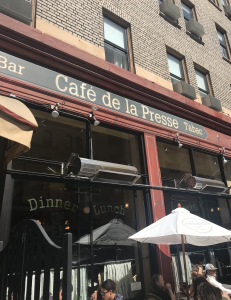
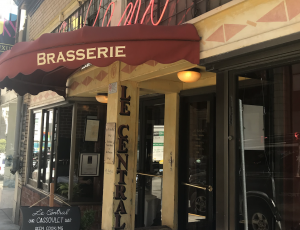
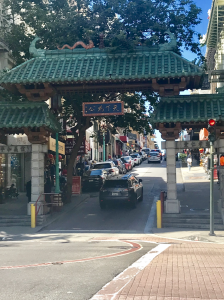
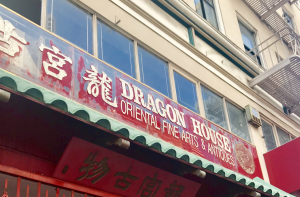
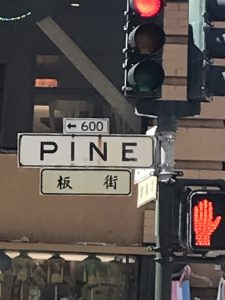
Works Cited
Leeman, J. & Modan, G. (2009), Commodified Language in Chinatown: a Contextualized Approach to a Linguistic Landscape. Journal of Sociolinguistics, 13(3), 332-362.
“One in Five U.S Residents Speak Foreign Languages at Home, Record 61.8 million.” Center for Immigration Studies, https://cis.org/One-Five-US-Residents-Speaks-Foreign-Language-Home-Record-618-million
It’s interesting how you note San Francisco’s high French population, as this is not something I previously knew about the city. Also, your explanation of how French is used for aesthetic, instead of communicative, purposes makes me consider why that may be the case. It’s a very aesthetically pleasing language, of course, but I wonder if many of the French people in SF have simply adapted and learned to use English as their primary language of communication (especially considering how similar the two languages are).
The commodified use of French you talk about seems similar to the commodification of various languages in Dublin. While Dublin is probably less diverse than San Francisco, it still has a lot of global brands and restaurants that tend to use languages other than English (French, Spanish, Chinese, etc.) on their storefronts, even if the owners and all the staff are Irish. Like you mention, this also serves no functional purpose to the community who actually speaks the language, since most people who go to these restaurants speak English and go for the appeal.
It was interesting to read about the usage of the French language in San Francisco. I’ve noticed that in many places around the U.S., would commodify French for businesses to draw people in. Is there a specific French district like there is a Chinatown? I appreciated that the Chinese language is used more for communication than just for aesthetic purposes. It is interesting how the marketing tacts are seen through architecture, rather than solely through language.
I agree with the fact that languages except English are sometimes only used because they have commercial values. It is the same situation in NYC. In central Manhattan, you rarely see anything in languages other than English. Only will you see Chinese in Chinatowns and Korean in Koreatowns. The vehicle of communication is still English and other languages are only there because they serve some specific purposes such as commercial values or attract tourists.
Gabriela,
Your discussion about the high French population in San Francisco was interesting because I feel that it tied very well to the Leeman and Modan reading this week. Just like their analysis of the use of language in Chinatown, it seems as if the use of French here is primarily to establish a certain ‘feel’ or ‘atmosphere.’ This commercialization of language is something I haven’t frequently encountered in Berlin, but I can still relate to your post because I have spent a considerable amount of time in San Francisco and New York as well, where I believe these issues are heightened.
I share your concern that non-English languages seem to be used primarily for their commercial benefit. It seems to be disingenuous on the part of business owners who only see the monetary benefit to using these languages while fundamentally ignoring the cultural benefits and diversity aspects of the languages used. Frankly, it is a shame that it feels this way, but as I expressed in class last week, I am not sure how to properly celebrate the various cultures of a city. On the one hand, you have artificial, commodified uses of language that cheapen the cultural depth of the experience. On the other hand, however, cordoning off a section of a city for a specific racial group to live in and “naturally” foster that culture seems like an attempt to ghettoize sections of a city. It is a difficult balance!
Hi Gaby, you make a lot of interesting points in this essay! I really enjoyed how you explored different languages and culture within San Francisco- I found that the topics you discussed about the French language and the Chinese arc reflected different issues that we discussed through texts and class that are found in commodifying specific cultural elements in specific cities.
HI QIQI 😀
Do u like my essay